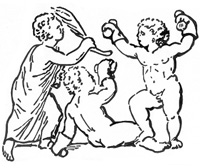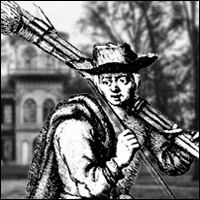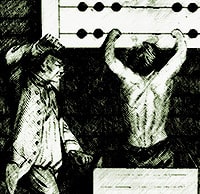Erique, a fighter I trained for a few years, who took the past year off of sparring and concentrated on his escrima instructor certification [Mind, you, in any martial arts scheme, Erique out ranks me in knowledge as he has become proficient in set pattern partner drills.] has returned to fight training and I’m pretty much beating him up. In the past, Charles and I were trying to figure out what it was about his traditional escrima study that retarded his progress.
It was easy to determine what it was about the traditional art that helped him in fluid contact situations. His checking hand is better than anybody, something that is constantly drilled in traditional settings, but only gets a fighter the win when he’s already beating the opponent. Like traditional karate, traditional FMA avoids contact in training and, in its focus on self-defense, assumes that the practitioner will have superior skills to the antagonist, who is assumed in most arts to be both untrained and unskilled.
Noting that Erique extensive stick-tapping drills had retarded his slash, I began limiting sparring to slash sparring, where there is no retraction of the weapon after contact but the stroke is driven through the target. As we did this slow-hand sparring he kept bringing his hand to rest at his naval, on his centerline, the last place you want your weapon hand.
Considering the stick drills I had once practiced with him under his instructor, I was able to identify the reason why traditional FMA practitioners, when they come over to a fluid format, get their hand hit constantly. I confirmed my suspicion by training one session under his teacher, with another student and himself. These drills—most of which may be traced through the various non-contact training formats promoted by Dan Inosanto and other FMA pioneers—develop as sympathetic feeder sequences in which the practitioner is judged effective in skill acquisition if he can make all of the beats and advance to the trap.
While some of these beats have proscribed hand positions that the stroke leads, to the chamber for the next stroke, the majority, in most of the dozens of sequences I have been unsuccessfully taught by a half dozen certified instructors, reward the stick tapper who brings his hand to centerline, exactly where you never want your weapon hand to come to rest in a contact situation but which permits more rapid stick tapping.
Whenever you stroke air or the bag or your partner when sparring, whether you are stroking through with a slash, smashing and driving your stick into the target, or jabbing and retracting your stick, bring your stick-hand to rest only at a power point:
1. Top of head, making contact with the wrist bone at the base of the thumb
2. Near shoulder
3. Far shoulder
4. Near elbow
5. Far elbow
6. Near hip
7. Far hip
Do yourself a favor and do not go from hip to hip or elbow to elbow.
Do note that all strokes in which the stick hand travels from near to far or from top to either, will bring the striking end of the stick through the space before the opponent’s center line. A hand in guard at the naval will be hit be shear accident. Use your drills to find a true contact guard, even when doing feeder drills.
Twerps, Goons and Meatshields: The Basics of Full Contact Stick-Fighting
link › jameslafond.blogspot.com











